Article of the Month - May 2020
|
Quantitative analysis of microplastics in
coastal sediment in beaches of Spain and Brazil
Ana Flávia Bastos, Brazil and D.Eng. Lia
Bastos, Brazil
This article in .pdf-format
(15 pages)
This peer review paper should have been presented at the FIG Working Week 2020,
Amsterdam, Netherlands in the special session
Mapping the Plastic.
Based on the ESMARES Program methods, a comparative study of the amount of microplastics found on different beaches of the
east coast of Spain, bathed by the Mediterranean Sea and the southern
coast of Brazil, bathed by the Atlantic Ocean has been carried out.
SUMMARY
Microplastics are small particles of plastic nature, with a size
smaller than 5 mm in diameter. These have a devastating potential in the
environment. There are several factors that can influence the
distribution of microplastics in the marine environment, such as wind
conditions, turbulence generated by boat traffic, anthropic activities
with a high degree of contamination and morphodynamic classification of
the shore line. The objective of this work is to carry out a comparative
study of the amount of microplastics found on different beaches of the
east coast of Spain, bathed by the Mediterranean Sea and the southern
coast of Brazil, bathed by the Atlantic Ocean. The methodology in both
environments was based on the ESMARES Program methods, with three
different steps: laboratory procedures, identification of microplastics
and comparative analysis. It was observed that in Spain, the beach of
Autocine had the highest amount of microplastics accounted for and the
beach of Puzol had the lowest. In Brazil, the beach that obtained the
highest number of microplastics was Brava and the one that obtained the
lowest was Atalaia beach. This paper concluded that the factors that
control the distribution of microplastics can be differentiated both
locally and globally. In the first case, a predominance of anthropic
factors is observed, influenced by morphodynamic characteristics and the
coastal drift. In the second, the distribution of microplastics seems to
be controlled, more, by the characteristics of the environment in which
they are located.
1. INTRODUCTION
Nowadays, plastic is one of the most widely used compounds in the
world, and can be found in many products worn daily, such as toiletries,
containers, plastic bags and others (KARAMI, 2017). It is esteem that
Europe accounts for 18.5% of world production and Latin America for 4%.
The Plastics Europe Organization estimated that there was an increase of
13 million tons between the year of 2016 and 2017, where the production
of 335 million jumped to 348 million tons (PLASTICS EUROPE, 2018).
Besides the exponential production of plastic just around 26% of the
world's plastic is currently recycled, while the remaining 74% is thrown
into the environment. Of the total plastics not recycled 28% are
untreated and often end up in rivers and lakes, 42% is sent to landfills
or dumps where the loss of plastic is not accounted for, and often its
final destination is the marine environment. The remaining 4% are found
in water treatment plants or are taken directly to the oceans (ALIMI et
al., 2018).
Although plastics have high durability, exposure to UV rays can cause
the elastic properties of plastic to diminish. Thus, plastics exposed to
UV rays are induced to oxidation and photochemical reaction, making them
fragile and brittle (SONG et al., 2017). Mechanical abrasion is another
process of plastic degradation by constant friction of wind, waves and /
or sand. Mechanical abrasion is more common on beaches, being considered
the most favorable environment for its fragmentation and erosion. (SONG
et al., 2017). This fragmentation originates small plastic particles
named microplastics.
Microplastics are small particles of a plastic nature, smaller than 5
mm in diameter (KANHAI et al., 2018) and have devastating potential in
the environment due to their small size and high dispersion, reaching
remote locations and possibly affecting several organisms independent of
their trophic level in the ecosystem (OLIVATTO et al., 2018).
The effect of the presence of microplastics in the marine environment
can be extremely detrimental due to their toxicity and bioaccumulation
properties, being consumed by small fish, molluscs and other marine
organisms, thus advancing trophic levels in the food chain (BELLAS et
al., 2016).
There are several factors that can influence the distribution of
microplastics in the marine environment, such as wind conditions,
environmental characteristics, turbulence generated by vessel traffic,
and highly polluted anthropogenic activities (OLIVATTO et al., 2018).
Chubarenko et al. (2018) studied the presence of microplastics in
different environments of a beach in the Baltic Sea and concluded that
local environment microplastics are brought towards the beaches with
circulation processes rather than being taken to open water. The study
by Carvalho & Baptista (2016) revealed that microplastics found in
Guanabara Bay, Rio de Janeiro, are from local environments such as
rivers, however, the anthropogenic activities performed in the area,
such as fishing and portuary activities can aggravate the situation and
increase the amount of microplastics in the region. Understanding the
effects of microplastics on nature helps preserve marine and coastal
environments.
2. OBJECTIVE
Compare the amount of microplastics found in different beaches of the
southeastern coast of Spain along the province of Valencia, bathed by
the Mediterranean Sea and in the beaches of northern Santa Catarina on
the south coast of Brazil, bathed by the Atlantic Ocean.
3. METHODS
The methodology used was conceived based in the program "ESMAREs:
Marine Strategies of Spain". The proposed methodology of this project
has three main steps: sample collection, laboratory treatment with
visual analysis of the samples and finally the comparison between the
quantities of microplastics found, using statistical analysis, data
population, morphodynamic characteristics of the beaches shore line and
the coastal drift.
The beaches of the study were characterized according to their
morphodynamics in dissipative, reflective and intermediate, according to
the Wright & Short (1983) classification. According to Tomazelli &
Villwock (1992), there is a lateral transfer of sediments, promoted by
the activity of waves that affect the coast, which for many years is
recognized as one of the most important factors responsible for the
configuration of sediments and beaches, called coastal drift. This may
also help explain the deposition of microplastics in the environments
and the morphodynamics that the beaches present.
3.1 Characterization of the Study Zone
3.1.1. Spanish Beaches
The beaches of the Spanish coast studied were: Puzol, Puebla Farnals,
Malvarrosa, Pinedo and Autocine (Figure 1). They are located in the
western basin, southeast of the Spanish coast, between latitudes 39 ° 20
'N and 39 ° 40' N and are influenced by the Mediterranean Sea.
Figure 1. Sample points in the Spanish beaches

The size of the population in the Mediterranean area is varied,
depending on the activities performed around the beaches (Table 1).
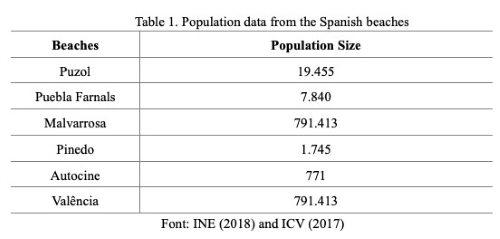
The beaches of Malvarrosa and Pinedo are based in the county of
Valencia. This two beaches along with Autocine are closest to the port
of Valencia and best known and frequently used by tourists. Both
activities are factors that influence the variability in the population
affecting the amount of pollutants found at the site.
Puebla Farnals and Puzol beaches are less well known to tourists and
are predominantly frequented by locals. Puebla Farnal beach is also
influenced by the presence of a marina.
The port of Valencia was built in the late 18th century and has
undergone changes and expansions over the centuries. Studies show that
the construction of the port changed the morphodynamic appearance of the
beaches located near it, the northern region suffered a sediment
accumulation advancing the shore line around 1 km (Pardo-Pascual &
Sanjaune, 2018). The Malvarrosa beach is located north of the port and
is subject to the high sediment retention indicating a possible change
in its morphodynamics and a dissipative beach classification.
The beaches located south of the port, such as Pinedo and Autocine,
suffered a high erosion that may have caused a greater slope in the
beach profile, suggesting that the beaches of Pinedo and Autocine are
classified as reflective. According to Muñoz-Perez et al. (2012) Puzol
beach has a steep beach profile with only 150 meters long and can also
be classified as reflective.
The Puebla Farnal beach was classified as intermediate beach since in
the region there was a predominance of beaches with this characteristic,
as can be observed in the work of Díez et al. (2017).
Using oceanographic buoy data, we were able to determine the
direction of the waves and the currents in the different zones studied.
Thus concluding that Spanish beaches suffer a north-south coastal drift.
This can be verified by analyzing the time series for 2016 and 2019
(Ministerio de Formento 2019 and Ministry of Development 2019)
3.1.2. Brazilian Beaches
The Brazilian beaches studied were: Balneário Camboriú, Brava,
Atalaia, Navegantes and Cabeçudas, which are influenced by the Atlantic
Ocean (Figure 2), located on the north central coast of the state of
Santa Catarina, in southern Brazil, between latitudes 27 ° 00 'S and 26
° 50' S.
Figure 2. Sample points of Brazilian beaches

The study area is located in the state of Santa Catarina, in the
counties of Balneário Camboriú, Itajaí and Navegantes. The IBGE made a
population estimative for 2018, which shows an important variation in
population size (Table 2). This population variability is due the
different activities provided for the population.
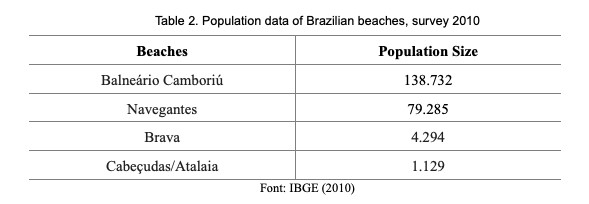
Atalaia and Cabeçudas belong to the same county (Itajaí), but there
is a greater concentration of the population in Cabeçudas. It is
important to emphasize that just like the Spanish beaches some Brazilian
beaches suffer a bigger impact by tourists.
Brazilian beaches had been classified according to the work of Wright
and Short (1983) in previous studies (Menezes, 1999; Abreu & Heidrich,
2012). According to Menezes (1999) the beaches of Balneário Camboriú and
Navegantes can be classified as dissipative beaches and Brava beach as
intermediate. Atalaia beach can be classified as dissipative and
Cabeçudas beach as reflective according to Abreu & Heidrich (2012).
3.2 Sample Collection
At each beach, three different samples were collected during the
winter period. The first point (P1) was intentionally chosen,
approximately in the center of the beach, and the other 2 points (P2 and
P3) were collected 10 meters from the original first point (Figure 3).
Figure 3. Distance and Spacing of sample points

Samples were collected using a 50 X 50 cm quadrant with 5 cm depth.
According to Carson et al. (2011), 50% of microplastics are located in
the first five centimeters of the sediment column.
After using the quadrant, the samples were homogenized and divided
into four equal parts (quadrant) and only one quadrant was collected.
Approximately 1 kg of sample was collected from the beaches for each
point and separated into plastic bags
3.3 Laboratory Treatment and Analysis
After sample collection, pre-treatment and subsequent laboratory
filtration were performed to separate the microplastics present in the
sediment. The following pre-treatment laboratory procedures were
performed:
- Homogenization and weighing of samples approximately 400 grams;
- Drying in oven at 60 degrees for 24 hours;
- Sieving in 4 and 1 mm meshes for 3 to 5 minutes;
The microplastic between 4 and 1 mm was identified and the remaining
sediment smaller than 1 mm suffered the following procedures to enable
the microplastics recognition:
- Removal of organic matter using 30% (v / v) hydrogen peroxide
for 24 hours.
- Treatment with saturated sodium chloride, approximately 150 ml,
homogenized for 5 minutes and decanted for another 5-10 minutes. The
homogenization and decantation process should be repeated twice.
- Filtration using a 0.47μm glass fiber filter of the supernatant
solution.
3.4 Sample Identification and Classification
For the identification of the microplastics, the glass fiber filters
were observed with the aid of a microscope lens with 4 times
magnification. Microplastics were identified and quantified according to
shape using the method of Stolte et al. (2014). A record of 50
microscopic fields was performed.
3.5 Comparative Analysis
After the identification and classification of the samples, the
results were statistically analyzed using the Rstudio software (RSTUDIO,
2019). The parametric statistical technique (ANOVA) was used.
4. RESULTS
After the identification and classification of microplastics no
fragments between 4 and 1 mm were found in both Spanish and Brazilian
beaches. Tables 3 and 4 show the number of microplastics accounted for
in Spain and Brazil respectively. Each column of the table represents
the total amount founded in the 400 grams in the fraction smaller than 1
mm.
Table 3. Microplastic identified in Spanish
beaches (Number of Particles in 400g)

Table 4. Microplastic identified in Brazilian
beaches (Number of Particles in 400g)
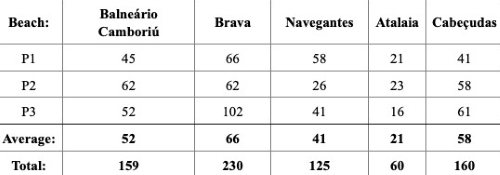
Table 3 shows that Autocine beach had the highest number of
microplastics accounted for and Puzol beach had the smallest amount. For
the analyzes performed in Brazilian beaches (Table 4) Brava presented
the highest total of microplastics and Atalaia the lowest.
The fragments were classified comparing their aspects with the types
of microplastics found in the study by Stolte et al. (2014). The ones
identified as microplastics can be seen in Figures 4A to 4D.
figure 4. Types of Microplastic Fragments
Identified.

Legend: A) White Fibers B) White Fibers C)
Conglomerate of Red and White Fibers D) Pink Fragment
In both countries the most commonly found form
of microplastics was fibers. Only a few samples showed small fiber
conglomerates (Figure 4C) and fragments of no apparent shape (Figure
4D).
4.3 Spanish Beaches Analysis
The data analyzed meet the normality requirements (Tables 5 and 6).

The ANOVA test presented p-value of 0.001. The Tukey test (Table 7)
identifies significant differences between the beaches.
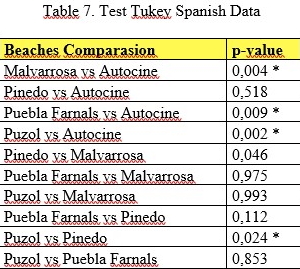
There was a significantly statistical different
amount of microplastics between the beaches analyzed.
Autocine and Pinedo are significantly different
from the others which was expected, since both are closer to each other,
have similar anthropogenic activities and are characterized as
reflective beaches. The rise of tourists in the region impacts and
increase the pollution, which may explain the high number of
microplastics present. Also, the beaches are classified as reflective
which can explain the high amounts of microplastics found, since these
beaches are able to retain most of the contaminants found in them.
The direction of the coastal drift (north-south)
can assist with the explanation, where microplastics may have a higher
deposition tendency on the southernmost beaches, such as Pinedo and
Autocine. The Port of Valencia is located in this area, but it was not
possible to state that the port activity contributes to the contribution
of microplastics.
The direction of the coastal drift (north-south)
can assist with the explanation, where microplastics may have a higher
deposition tendency on the southernmost beaches, such as Pinedo and
Autocine. The Port of Valencia is located in this area, but it was not
possible to state that the port activity contributes to the contribution
of microplastics.
4.4 Análise Praias do Brasil
After proving the normality requirements (Tables 8 and 9) it was
proceeded exactly as in the Spanish beaches.

In this case the ANOVA also presented a p-value of 0.001. The Tukey
test (Table 10) shows the significant differences between the beaches.
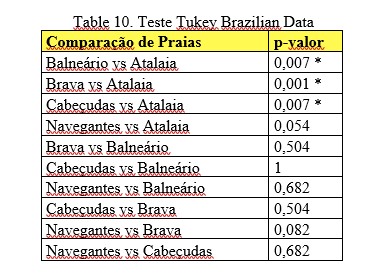
Brava, Cabeçudas and Balneário Camboriú presented higher amounts of
microplastics. These beaches are also the ones that receive the largest
number of tourists throughout the year for that reason it is common to
find bars and small vendors through the beach. In the case of Cabeçudas,
some bars use the beach as part of their establishment, placing plastic
chairs and tables along the sand. All of these factors may contribute to
the microplastics set on the region.
Although the three beaches (Brava, Cabeçudas and
Balneário Camboriú) did not presented a significant statistical
difference, the distribution of microplastics can be analyzed according
to their morphodynamics classification and coastal drift, as well as the
influence of the rivers present in the region.
Balneário Camboriú is classified as dissipative
indicating that the beach may have a facility to disperse the
microplastics and a tendency to accumulate on the edges of the shore
line due to the coastal drift, point located away from the sample point.
Cabeçudas and Brava beaches are characterized as
reflective and intermediate, respectively, which may indicate greater
retention of microplastic at the central point. In both cases, both in
Brazilian and Spanish beaches, confirm the results previously obtained
by authors such as Carvalho and Neto (2016) and Bosker et al. (2018),
which is the origin of microplastics is from marine environment such as
rivers and the ocean, anthropogenic activities performed in the area
increase the amount of microplastics in the shore line.
4.3.3 Análise Espanha vs Brasil
Finally, a comparison between the beaches of Spain and Brazil,
concluded that the both countries have significant statistical and high
difference between the number of microplastic founded (Figure 5).
Figure 5. Comparison between Spanish and
Brazilian Beaches
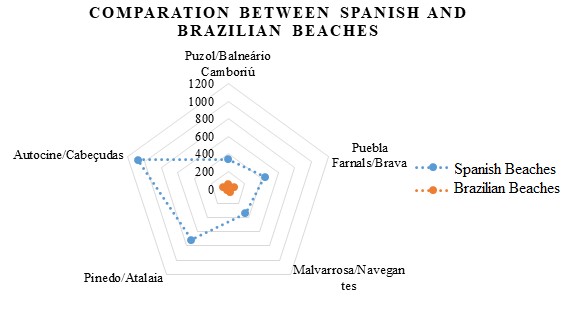
Figure 5 shows that all the studied beaches of
Spain have much higher number of microplastics than the Brazilian
beaches. When comparing Figure 6 and Figure 7, it can be observed that
none of the 5 Brazilian beach, regardless of whether or not it has a
characteristic similar to a Spanish beach, obtained similar amount of
microplastics.
Figure 6. Quantity of microplastic in each Spain
beach
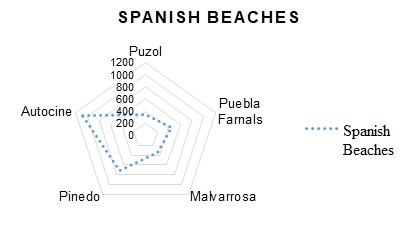
Figure 7. Quantity of microplastic in each
Brazilian beach
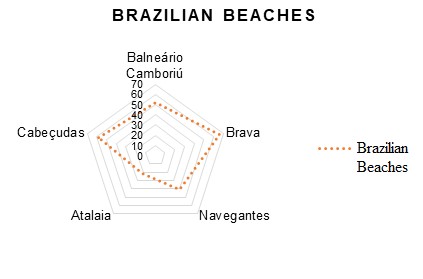
Chubarenko et al. (2018), says that the
microplastics found on sandy beaches are likely originated in the marine
environment they are affected by, this could explain why there is such a
difference between the countries studied.
The amount of microplastic in Spain is higher
because the Mediterranean has a higher retention of pollutants than the
Atlantic Ocean. Moreover, when observing the currents that influence the
study areas, it is possible to verify that in the Brazilian beach region
the South Atlantic current flows in the opposite direction of the
beaches, possibly displacing the microplastics away from the coast. In
contrast, in Spanish beaches where the currents of the Mediterranean Sea
do not allow such an intense flow of water exchange in the region
possibly causing a greater retention in the amount of microplastics.
Finally, by comparing our study with the study
of Vianello et al. (2013) done in the Lagoon of Venice the amount of
microplastic found of 2175 to 672 particles in kg was inferior. However,
comparing with another study in sediment from China the amount of
microplastic found 435 to 250 in only 50 grams of dry sediment was
superior to our study (QIU, Q. et al., 2015).
5. CONCLUSION
In conclusion there is a difference between the amount of
microplastics found in different beaches of the east coast of Spain and
the south coast of Brazil. Beaches bordering the Mediterranean Sea had a
higher number of microplastics.
A statistical difference was identified between the Autocine and
Pinedo beaches compared to the Malvarrosa, Puebla Farnal and Puzol
beaches, where the former had a higher amount of microplastics. In the
case of Brazilian beaches, Brava, Cabeçudas and Balneário Camboriú
beaches presented a higher amount of microplastic than Atalaia and
Navegantes beaches.
Due the variability in the amount of microplastic founded in
different papers in the existing literature, it’s important the
deepening of this study area.
REFERENCES
-
Alimi O S, Budarz J F, Hernandez L M,
Tufenkji N. (2018) “Microplastics and Nanoplastics in Aquatic
Environments: Aggregation, Deposition, and Enhanced Contaminant
Transport.” Environmental Science & Technology,52(4), p: 1704-1724.
-
Bellas J, Martinez-Armental J,
Martinez-Camara A, Besada V, Martinez-Gomez C., (2016) “Ingestion of
microplastics by demersal fish from the Spanish Atlantic and
Mediterranean coasts.” Marine Pollution Bulletin, v.109(1), p:
55-60.
-
Bosker T, Guaita L, Behrens P., (2018)
“Microplastic pollution on Caribbean beaches in the Lesser
Antilles.”, Marine Pollution Bulletin, v. 133, p :442-447.
-
Carson, H. S.; Colbert Kaylor M. J.;
Mcdermid K. J. (2011) “Small plastic debris changes water movement
and heat transfer through beach sediments.” Marine Pollution
Bulletin, v. 62(8), p. 1708-1713.
-
Chubarenko I P, Esiukova E E, Bagaev A V,
Bagaeva M A, Grave A N. (2018) “Three-dimensional distribution of
anthropogenic microparticles in the body of sandy beaches.”, Science
of the Total Environment., v. 628-629, pp:1340-1351.
-
De Carvalho D G, Baptista Neto J A. (2016)
“Microplastic pollution of the beaches of Guanabara Bay, Southeast
Brazil.” Ocean and Coastal Management., v. 128, pp:10-7.
-
Díez, J.; Cánovas, V.; Uriarte, A.; Medina,
R. (2017) “Characterization of the Dry Beach Profile: A
Morphological Approach.” Journal Of Coastal Research, v. 33, n. 6,
p.1292-1304,
-
Heidrich, C.; Abreu, J. G. N. (2012)
“Caracterização Das Praias De Navegantes E Itajaí (Sc) Em Relação Às
Características Sedimentológicas E Composição Dos Minerais Leves
(Quartzo E Feldspato).” Science technology., v.16 (2), p: 37-94.
-
Instituto Brasileiro De Geografia E
Estatística, (2019) Censo Demográfico 2018. Disponible in:
https://www.ibge.gov.br/apps/populacao/projecao/por%20municipio
Access [10-06-2019]
-
Instituto Nacional De Estadística (2018)
Cifras oficiales de población resultantes de la revisión del Padrón
municipal a 1 de enero. Disponible in:
http://www.ine.es/jaxiT3/Tabla.htm?t=2903&L= [Access
10-06-2019].
-
Istitut Cartogràfic Valencia, (2016)
Distribuició de la població: Aspectes generals. Demografia de la
Comunitat Valenciana. Disponible in:
http://www.icv.gva.es/auto/aplicaciones/Atlas/Demografia/?locale=vl
[Access 10-06-2019]
-
Ivleva N P, Wiesheu A C, Niessner R., (2017)
“Microplastic in Aquatic Ecosystems.” Angewandte Chemie:
-International Edition., v.56(7), pp: 1720-1739.
-
Kanhai L D K, Officer R, Lyashevska O,
Thompson R C, O'connor I. (2017) “Microplastic abundance,
distribution and composition along a latitudinal gradient in the
Atlantic Ocean.” Marine Pollution Bulletin., v. 115(1-2),
pp:307-314.
-
Karami A. (2017) “Gaps in aquatic
toxicological studies of microplastics.” Chemosphere.,
pp.184:841-848.
-
Menezes, J. T. (1999) “Aspectos
Morfodinâmicos Das Praias Do Litoral Centro-Norte Catarinense. ”
Monografia (Especialização) - Curso de Ocenaografia, Universidade do
Vale do Itajaí, Itajaí.
-
Ministerio de Fomento (2019). Puertos del
Estado. Disponible en:
http://www.puertos.es/en-us/oceanografia/Pages/portus.aspx.
[Acesso 04-07-2019]
-
Muñoz-Perez, J. J.; Roman-Sierra, J.; Payo,
A.; Navarro-Pons, M. (2011) “Optimization of beach profile spacing:
an applicable tool for coastal monitoring.” Scientia Marina, v.11,
p.1-9.
-
Olivatto, G. P., Carreira R., Tornisielo, V.
L., Montagner, C.C. (2018) “Microplastics: Contaminants of Global
Concern in the Anthropocene.” Revista Virtual de Química, v. 10(6),
pp.1968-1989.
-
Pardo-Pascual, J. E.; Sanjaume, E. (2018)
“Beaches in Valencian Coast”. MORALES, Juan A. (Ed.). The Spanish
Coastal System: Dynamic Processes, Sediments and Managment. Springer
International Publishing. Cap. 10. p. 209-236.
-
Plastics Europe: Association of Plastic
Manufacturers (2018) Plastics - the Facts 2018: An analysis of
European plastics production, demand and waste data. Bruselas.
-
RSTUDIO Team RStudio: (2019) Integrated
Development for R. RStudio, Inc. Versão 1.2.1335.
-
Song Y K, Hong S H, Jang M, Han G M, Jung S
W, Shim W J. (2017) “Combined Effects of UV Exposure Duration and
Mechanical Abrasion on Microplastic Fragmentation by Polymer Type.”
Environmental Science & Technology., v. 51(8), pp. 4368–4376.
-
Stolte A, Forster S, Gerdts G, Schubert H.
(2015) “Microplastic concentrations in beach sediments along the
German Baltic coast.” Marine Pollution Bulletin., v. 99(1-2), pp.
216-229.
-
Tomazelli, L. J. & Villwock,J., A. (1992),
“O cenozóico Costerio do Rio Grande do Sul”. Geologia do Rio Grade
do Sul, pp:375-406.
-
Vianello, A., Boldrin, A., Guerriero, P.,
Moschino, V., Rella, R., Sturaro, A., & Da Ros, L. (2013).
“Microplastic particles in sediments of Lagoon of Venice, Italy:
First observations on occurrence, spatial patterns and
identification.” Estuarine, Coastal and Shelf Science, 130, 54–61.
-
Qiu, Q., Peng, J., Yu, X., Chen, F., Wang,
J., & Dong, F. (2015). ”Occurrence of microplastics in the coastal
marine environment: First observation on sediment of China.” Marine
Pollution Bulletin, 98(1-2), 274–280.
-
Wright, J. D.; Short, A. D. (1983)
“Morphodynamic variability of surf zones and beaches: A synthesis.”
Marine Geology, v. 56, p.93-118.
BIOGRAPHICAL NOTES
Ana Flávia Bastos holds a double Degree program
of the Oceanography course at the Universidade do Vale do Itajaí and the
Universidad Católica de Valencia. CAPES Scholar of the Science Without
Borders program at the Florida Institute of Technology in the
Oceanography course (2015-2016). Class Instructor of the Community
Ecology Laboratory. Intern at the University of Northern Iowa in the
Department of Geology. Intern at AMBIENS S.L. (Spain) in the area of
management and coastal impact.
Lia Caetano Bastos holds a degree in Civil
Engineering from the Federal University of Santa Catarina (1981), a
master's degree in Production Engineering from the Federal University of
Santa Catarina (1987) and a doctorate in Production Engineering from the
Federal University of Santa Catarina (1994). She is currently a
Distinguish Professor at the Federal University of Santa Catarina. Has
experience in Urban and Regional Planning, focusing on Urban and
Regional Planning and Design Techniques, acting on the following
subjects: remote sensing, decision making, geographic information system
and information quality.
CONTACTS
Ana Flávia Bastos
Universidade do Vale do Itajaí
Rua Uruguai,458 – Centro, 88302-901
Itajaí -SC
BRASIL
Lia Caetano Bastos, Dra
Universidade Federal de Santa Catarina
Rua Engenheiro Agronômico Andrei Cristian Ferreira – Trindade, 88040-900
Florianópolis - SC
BRASIL





































